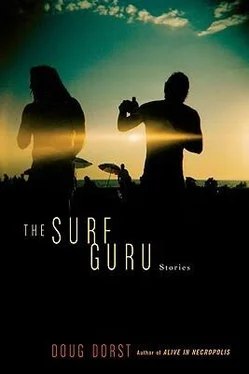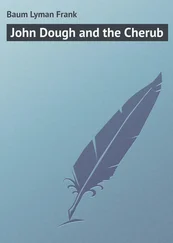The air around me is chilly and spiced with formaldehyde. My friend calls from down the hallway, tells me to hurry up because we have much more to see in the museum tonight: the lab where a T. rex is being reassembled; a fearsome collection of shark jaws; the insane menagerie that is the birds-of-prey specimen room. I let my hand drop from the curator’s door, suddenly sheepish. I am forty and graying; by now I ought to know what, if anything, I will give my life to, or for.
In the distance, down some other hallway of the vast museum, a floor polisher thrums and thrums, getting the place clean for tomorrow’s visitors.
Christopher, the best man, is on his fifth rum-and-Coke when the music stops and the stage is cleared and his thoughts turn to Jamaica. To the inn in Montego Bay where he proposed to the woman who is now his wife. To the garden where they had their breakfast the following morning. To the creature they saw darting across one of the flower beds. The strangest thing: a lizard head on a thick, stubby-snake body with cartoonishly tiny legs and feet. It paused on a flat rock, and they admired it until the gardener, a dark-skinned man in flawless white linen, crept up to the creature and smoothly decapitated it with one strike of his shovel. “Galliwasp,” the man explained to them. “Most dangerous ting on de island. Got venom in dey teeth.” He scooped up the two pieces of the reptile with the shovel and carried it away, whistling, leaving them to their plates of ackee fruit and saltfish and their stunned silence. What they found out later, back at home, surprised them even more: galliwasps aren’t venomous. Aren’t dangerous at all. The lore is a lie, and the damned things are nearly extinct because of it.
There’s another piece of island wisdom about the galliwasp: If one bites you, you’re supposed to run for the nearest water. If you get to water before it does, then you’ll live and it will die. If it gets to water first, you’ll be dead before the next sunrise.
Christopher wants to share this with the guys at the table — it feels important, somehow, in his rum-fogged mind — but they’re all busy scoping out the lap-dance talent and conferring with each other on same, and the groom-to-be is already blind on tequila shooters, and now there’s a new girl on stage and the music starts pumping again. He couldn’t make himself heard if he wanted to.
He looks around the table. Eight men. They’ve been friends since they were teenagers; they’ve screwed some of the same girls; they’ve boasted-slash-confided about sloppy-drunk hookups, about each of their Top Five Blowjobs lists, about conquests in bathroom stalls and faculty offices and graveyards and parking lots and airport hotels and delivery vans and dank basements while parties thump away overhead, about the demure girls who fuck like wildcats, about walks of shame and cold sores and amoxicillin, about the I-swear-I’ll-call-you-agains and the Ones That Got Away. And now he understands why his thoughts are on Jamaican galliwasps instead of the C-cup cowgirl pole-dancing ten feet away: all of them spent the first two decades of their adult lives treating sex like a galliwasp bite. There is the bite, and then there’s the running. You might be the reptile or the human, you might be the biter or the bitten — you might not even be sure which one you are — but the barest fact of it remains: Jaws sink into flesh, and then you’re both running for the water. All those bites, all those sprints, all those deaths by sunrise. But it’s different, he thinks, now that they’ve gotten older, now that they’re settling down. It’s different. Isn’t it?
This feels like a question that should not be contemplated with an empty glass. He raises his hand and tries to catch the eye of the bone-skinny cocktail waitress, who for some reason is dressed like a matador.
The Argus monitor, a.k.a. Varanus panoptes , is a diurnal metaphor and an important predator in today’s global biomeme.

In Greek mythology, Argus Panoptes was a giant with a hundred eyes who was assigned by Hera to guard a white heifer from Zeus, that crazed rutter.
The Argus monitor has sharp claws for digging, climbing, and ripping apart aesthetic distance.
The Argus monitor is a major employer in most American cities and towns, but it is nervous and quick to startle.
When scanning its environs, the Argus monitor will often “tripod”—i.e., raise itself high on its hind legs and tail. It sees all. Keep your shoes shined, your underthings clean, and your paperwork up to date.
A powerfully built, rapacious eating machine, the Argus monitor is the “bottomless pit” of the animal kingdom, feeding on snakes, insects, corn syrup solids, rodents, birds, consent, The Fountainhead , frogs, rage, synecdoche, arbitrage, apathy, wounded dingoes, Tibet, that new car smell, situation comedy, marketing majors, Bowery river crab, restraint, theocratic impulses, the Rule Against Perpetuities, wonder, exhaustion, degenerate art, collateralized prey obligations, the missionary position, phenomenology, cake, the proposed Trans-Afghanistan pipeline, and, in times of scarcity, other monitors.
Off camera, Marlin Perkins would refer to the Argus monitor as “a bad mamma-jamma.”
The Argus monitor’s droppings are superconcentrated pellets of hope and bones, prized as trophies by some and as protein sources by others. More precise demographic breakdowns remain unavailable, however, due to budget cuts at the research facility.
The Argus monitor pays well. Sweet rutting Zeus, does it ever.
On March 14, 1983, an Argus monitor urinated on Johnny Carson’s shoulder during a live broadcast of NBC’s Tonight Show . When they cut to commercial, it tore off and devoured both of the TV host’s legs.
The Argus monitor offers many opportunities for intern-ships as well.
Venom? Damn skippy!

It prefers to bask in the morning, with a two-gallon MonolithiGulp™ of coffee, a raw goat, a bowl of white phosphorus, and the Wall Street Journal it has swiped from its neighbor’s driveway.
The Argus monitor has a forked tongue and a vomeronasal organ in the roof of its mouth, which is why one should not speak ill of it. And also on account of it pays so well.
Its underside is cream-colored and surprisingly soft.
Last night, S. — , a thirtyish man, dreamed that he was sitting on the couch with his wife — not his real wife, but a dark-haired dream-understudy whose face he was never able to see clearly. They were watching a show called Hot Herps on the Circle Of Life Channel, which was following up a feature on “Lizards That Eat Their Young” with a profile of a species of viper called the daboia (whose name comes from Hindi for “lurker”). In one clip, an Indonesian field-worker presented with a daboia bite on his hand. The wound was blistering, the arm swollen to more than twice its normal size. A real-time computer simulation reenacted the bite, showing a daboia being held — much as that infamous boomslang was — with fingers carefully arranged around the head, pinning the jaw. Then: a flash of movement, a whip-flick of brown and black, and suddenly snake and hand were attached by a pair of long, curved fangs. Normally, bites like this are due to careless handling or inattentiveness , the narrator said, but not in this case . The simulation ran again, in super-slow motion, revealing the snake’s secret: unable to break the man’s grip, it had struck the only way it could. It had bitten through its own lower jaw to get at the man’s hand. S. — backed up the DVR, and he and his dream-wife watched the simulated strike over and over, rapt, alive with this glimpse of the pure, concentrated menace of the natural world. He put his hand on her neck and felt her skin warming.
Читать дальше














